The Ultimate Guide to Creating a Thriving Learning Culture in 2023
In this in-depth guide, we’ll cover all you need to know about creating and fostering a healthy learning culture for your organisation. From understanding what a learning culture truly means and why it matters, to exploring its fascinating history and the implications for individuals, teams and organisations.
Discover how improving and nurturing your organisation's learning culture will unlock endless potential for growth and success. We’ll provide you with practical insights, expert advice, as well as inspiring examples from companies that are reaping remarkable rewards.
Lastly, we’ll share invaluable best-practice tips to guide you on your journey to fostering a vibrant and engaging learning culture.
So, get ready to dive in, explore, and unleash the power of learning culture within your organisation!
Table of contents

Chapter 1
What is learning culture, Anyway?
(And why does it matter?)
It’s the everyday unofficial ‘way we do things around here’, and the shared characteristics among people.
Another definition by Martin & Nakayama explained culture as the learned patterns of perception, values and behaviours, shared by a group of people, that are dynamic and diverse.
Daniel Coyle who wrote the book The Culture Code: The Secrets of Highly Successful Groups, describes culture as, “…a set of living relationships working toward a shared goal. It’s not something you are. It’s something you do”.
So, what does this mean when it’s connected to learning?
"Design creates culture. Culture shapes values. Values determine the future." - Robert L. Peters
Learning culture, a definition
While there’s no ‘winner takes it all’ definition or theory of learning culture, there are key themes that stand out. Here’s what we reckon…
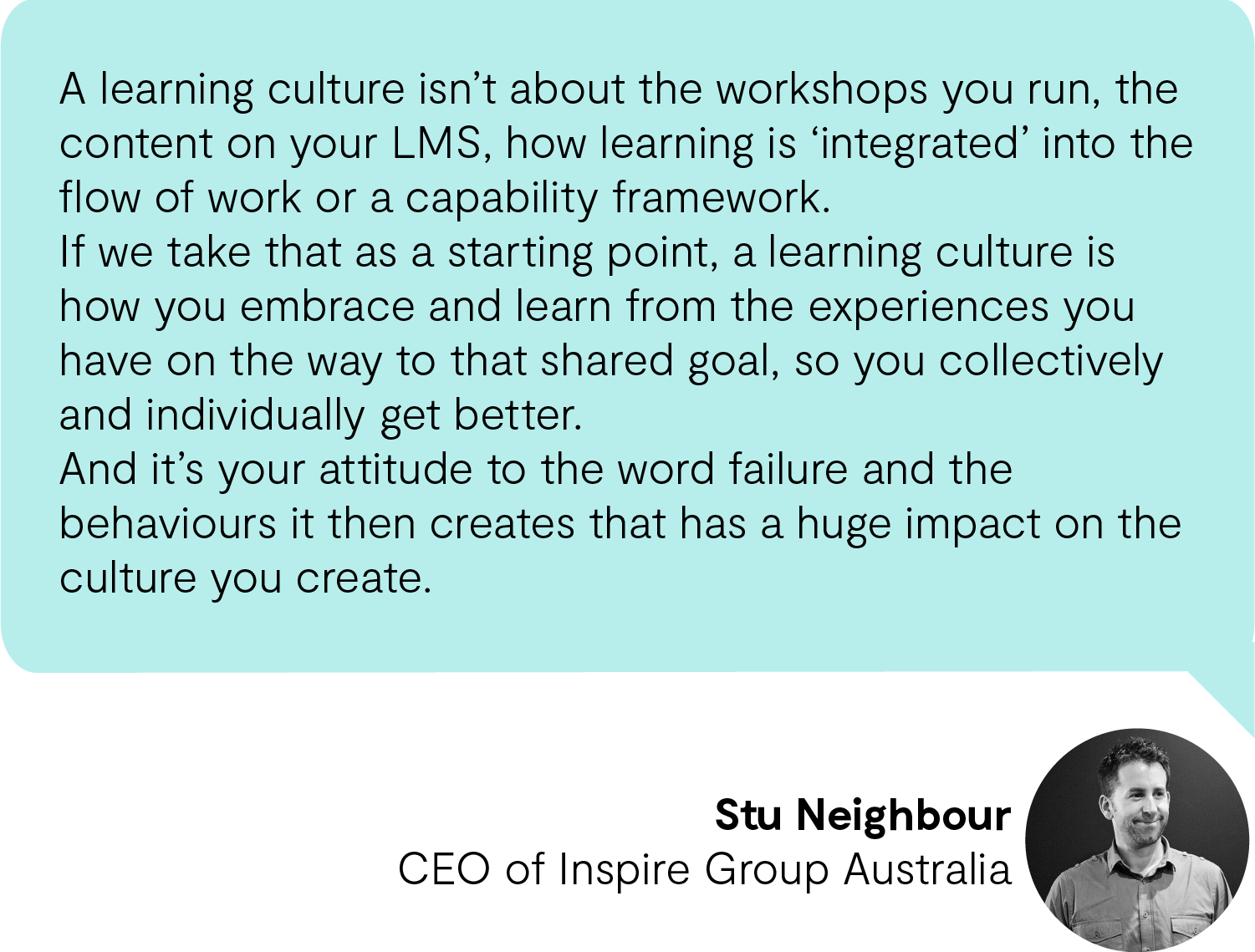
Hey, it’s not just about what we think.
We also found that there are several definitions of learning culture, and sometimes it seems to be used interchangeably with related concepts such as ‘learning organisation’ and ‘learning climate’.
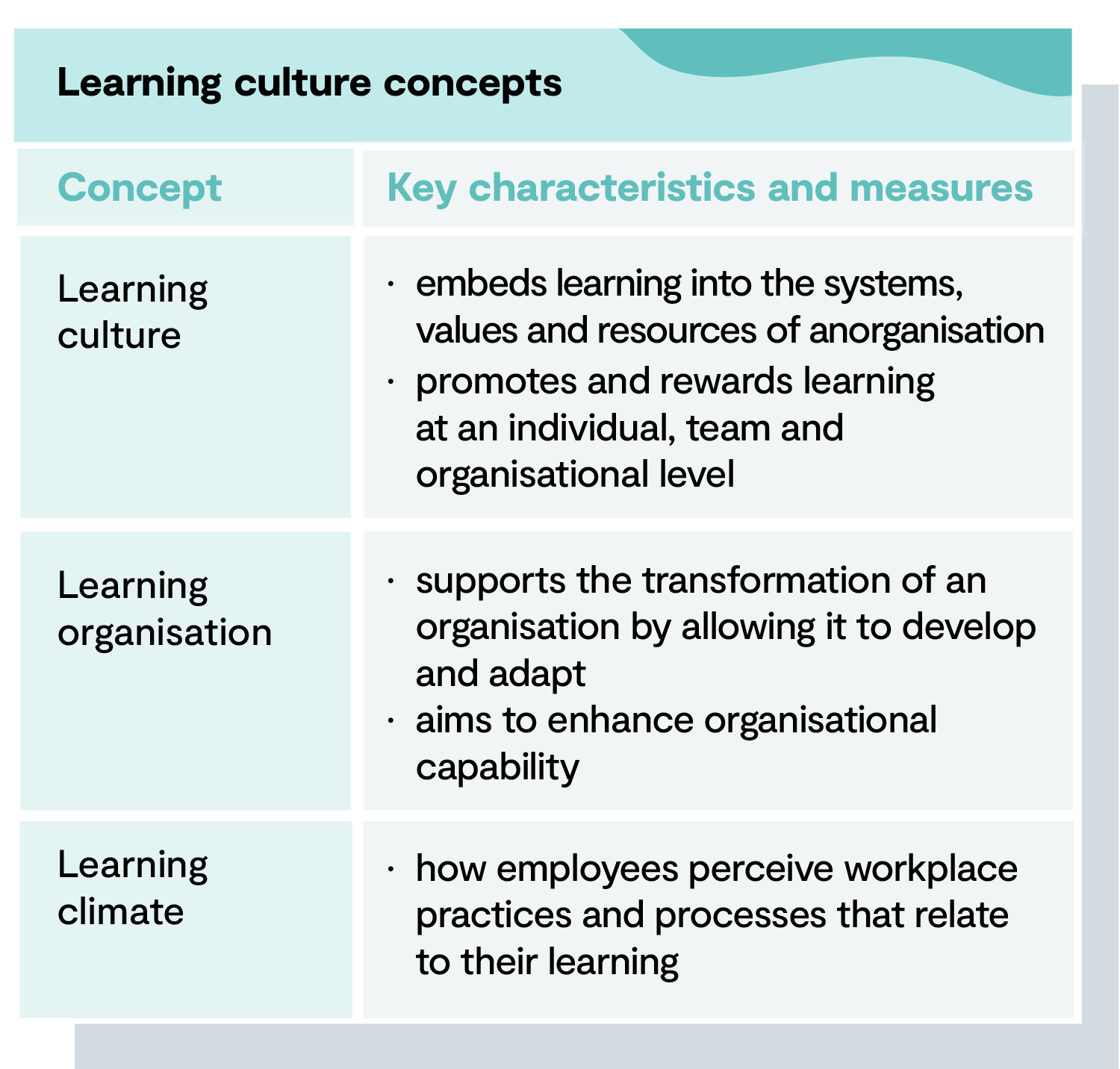
In summary, a learning culture refers to a workplace where learning:
- is at the forefront
- means you are not afraid of failure
- is continuous and encouraged through an environment that fosters growth and development
- takes place at an individual, team and organisational level
- is at the core of the organisation's values and practices.
The history of learning cultures in organisations
How did the idea of learning culture come about? Check out this timeline of the key milestones in the history of organisational learning.
We haven’t gone into too much detail here, otherwise we might have to call this post ‘From Stone Tablets to Now: The Epic Saga of the History of Organisational Learning’ – but you get the idea. Here’s a neatly packaged history of the influences, and influencers, on the concept of learning culture as we know it today.
Click here to download the infographic
As you can see, the thinking around what makes up learning culture has grown and changed over the years as workplaces and industries have evolved.
As a result, there is now a much greater emphasis on learning as something continuous (not a one-off event), with ownership spread across a whole organisation, not just an HR or L&D department – and where more and more, learning is integrated, both at an organisational level (in strategy) and at a learning level (in the flow of work).
Why does learning culture matter?
It’s been more than 10 years since Bersin released his report on learning culture in 2010 and we still talk about the importance of building a learning culture.
More recently, Deloitte's 2019 Global Human Capital Trends report found that more organisations talk about having a good learning culture than the number of organisations that have actually achieved it.
Only 11% of the survey participants said their organisation had an excellent learning culture, and less than half (43%) said their learning culture was good.
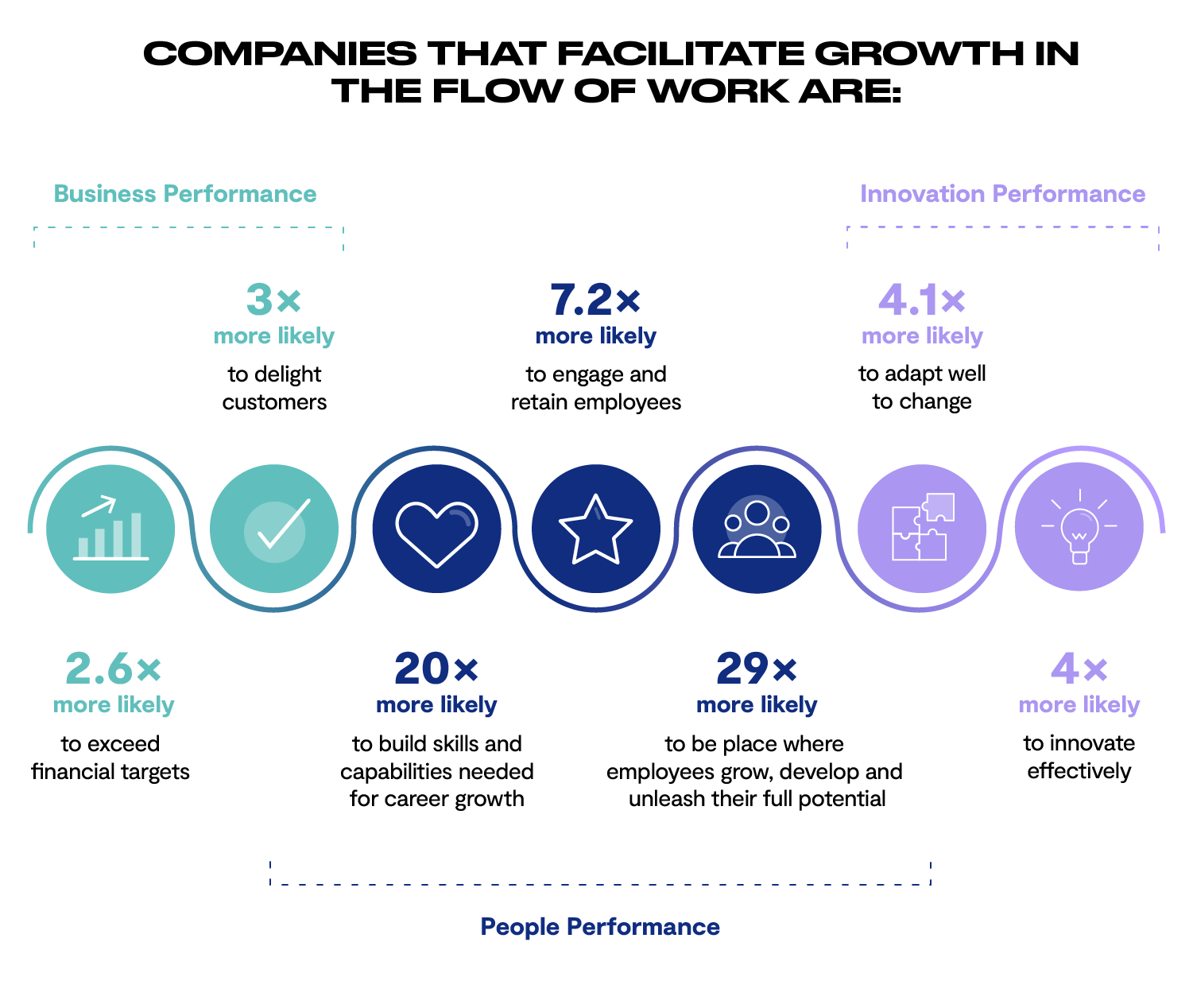
With all this in mind, why does it matter whether your learning culture is kicking butt?
A great, ‘butt-kicking’ workplace learning culture offers numerous benefits. According to the Definitive Guide to Corporate Learning: Growth in the Flow of Work from Josh Bersin Research 2022, organisations with a strong learning culture and a high level of learning maturity (‘that deploy practices that facilitate growth in the flow of work’) were:
- 6 times more likely to exceed financial targets
- 3 times more likely to delight customers
- 20 times more likely to build skills and capabilities needed for career growth
- 2 times more likely to engage and retain employees
- 4 times more likely to innovate effectively.

Chapter 2
benefits of a Great learning culture
Investing in a culture of learning isn’t just something that positively impacts your people, we also know that it drives better outcomes for individuals, teams and your whole organisation.
The Chartered Institute of Personnel and Development, in its 2020 report 'Creating Learning Cultures: Assessing the Evidence', says that there are three common themes found in thriving learning cultures:
- Helping individuals learn and grow and using that knowledge to shape how a business operates and makes decisions.
- Inspiring teams to learn from their work and reflect on how they can contribute to improving strategies and processes.
- Being open to learning from the entire organisation and important decision-makers and using that knowledge to make improvements.
Let’s look at what the implications and benefits might be for each of these three themes when a learning culture is in play.
 |
Individual learning |
Employee development and growth
A great learning culture enables employees to grow personally and professionally, enhance their skills, perform better, and advance in their careers.
A 2023 HR trends survey found that 49% of employees plan to explore their career options this year. And beyond the obvious factors of wanting higher pay and greater flexibility, 21% who left their jobs in 2022 stated: “There wasn’t room for growth.”
When asked, ”Does your employer provide the following to support your career growth?” less than half of employees say their employers offer opportunities for upskilling (expanding upon their current skill set), and only 35% say there are opportunities to learn a new skill set (reskilling). Clearly, there’s room for improvement.
Increased employee engagement
In organisations where there is a strong culture of learning, employees see that their growth matters. Engaging in meaningful learning experiences and having chances for advancement leads to higher employee engagement.
Engaged employees are more committed, motivated and excited about their work, which boosts productivity and performance.
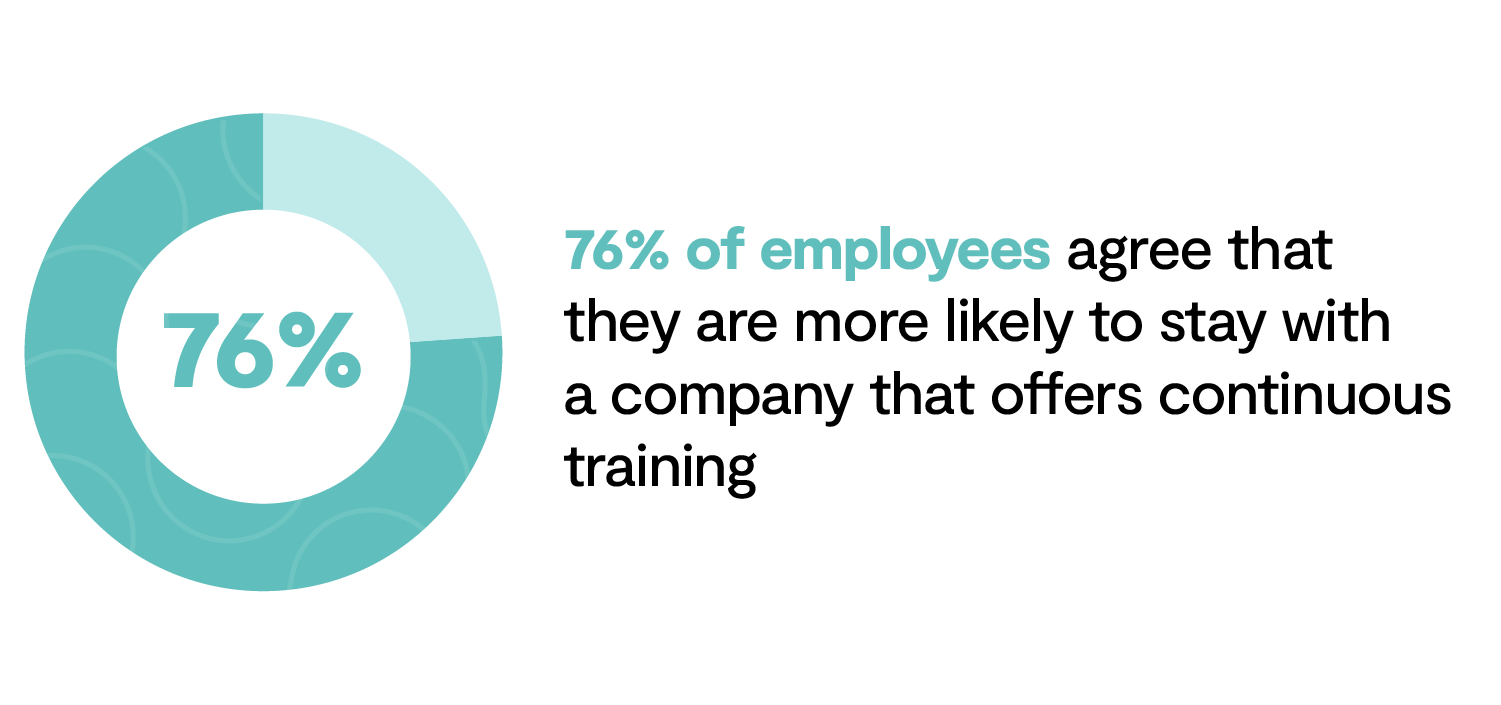
 |
Learning in and across teams |
Knowledge sharing and collaboration
A learning culture promotes knowledge sharing and collaboration.
When people are encouraged and feel safe to share their expertise, insights and experiences, and ask questions, it creates an environment where everyone learns from each other, solves problems together and benefits from their collective intelligence. This enhances organisational learning and effectiveness.
Research indicates that knowledge management and knowledge sharing are linked to a thriving learning culture.
For example, one study found a link between a strong culture for learning and better knowledge management practices, such as training employees to transfer skills. As a result, it led to better-skilled employees and improved overall organisational performance.
Another study found a significant direct relationship between learning culture and knowledge-sharing behaviours.
How would you know whether your learners are any good at knowledge-sharing behaviours?
Tools like Gallup StrengthsFinder encourage building strengths and getting to know those of others rather than every individual being expected to be good at everything; these have been a growing area of focus for organisations over the last 10 years.
Want to learn more about StrenghtsFinder? Here's a StrengthsFinder summary describing everything from its origins to how to use StrengthsFinder results.
 |
Organisational learning |
Retention of top talent
A strong learning culture attracts and retains top talent. Employees who value their growth and development are more likely to stay with organisations that support and nurture their career journey.
An IBM study focusing on the value of employee training showed that 84% of employees within the best-performing organisations are receiving the training they need compared with 16% in the worst-performing companies.
And investment in learning is one of the major reasons they would decide to stay in a role for longer. Combining role clarity and continuous learning opportunities that support people to perform to those expectations, organisations gain a competitive edge in attracting and keeping skilled and motivated employees.
Adaptability and innovation
Learning cultures foster adaptability and a growth mindset. When employees are encouraged to explore new ideas, experiment and keep learning, they become more adaptable to change.
This enables organisations to respond effectively to market shifts, technological advancements and evolving business needs. Additionally, a culture that promotes learning and knowledge sharing stimulates innovation and encourages employees to generate creative solutions and contribute new ideas.
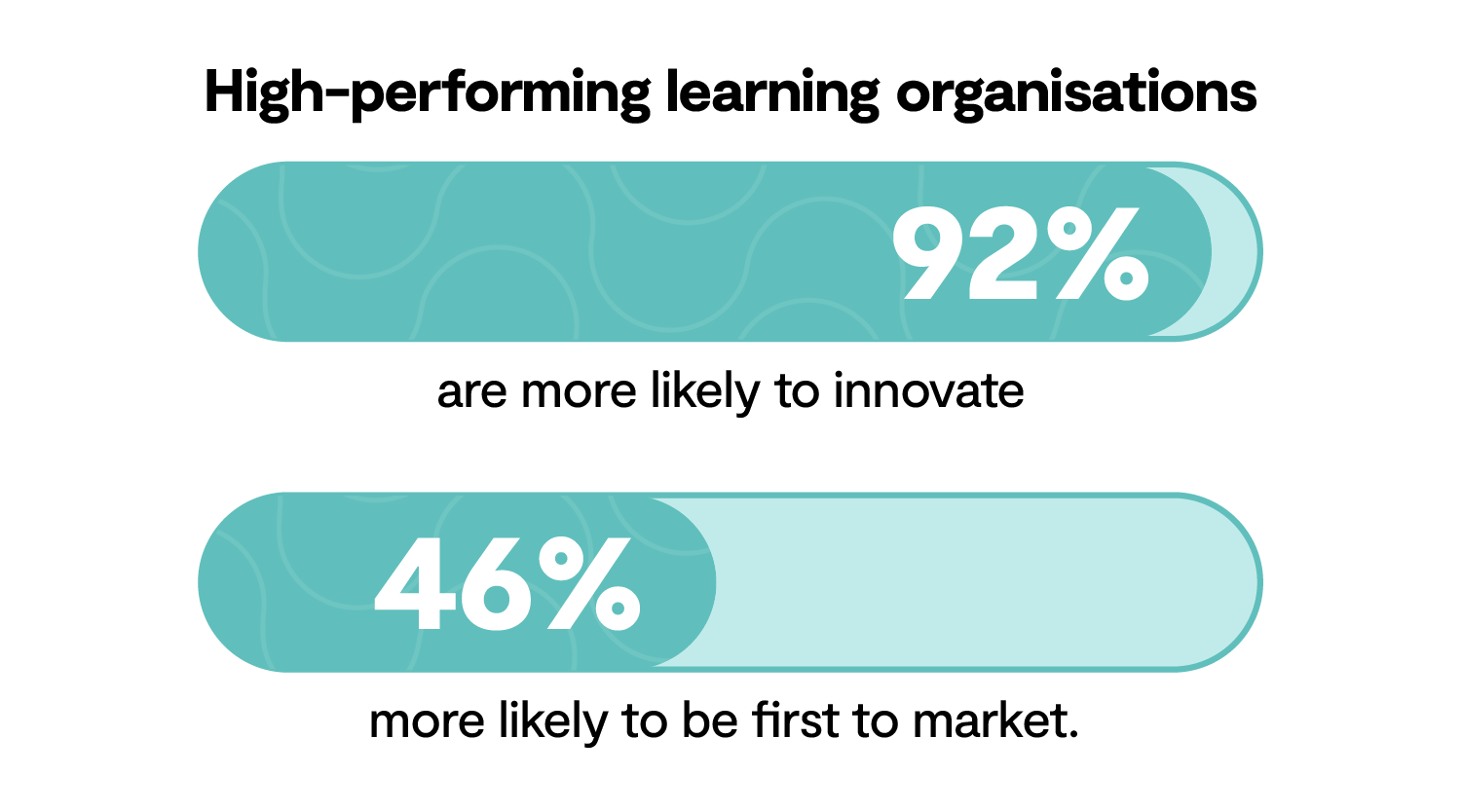
According to research by Bersin by Deloitte, high-performing learning organisations are 92% more likely to innovate and 46% more likely to be first to market.
Increased productivity and performance
Investing in learning culture directly leads to improved productivity and performance. As employees acquire new skills and knowledge, they become more efficient, effective, and capable of handling complex tasks.
Continuous learning ensures employees stay up to date with industry trends and best practices, enabling them to perform their best and deliver high-quality results.
According to Bersin by Deloitte research, high-performing learning organisations see 37% greater employee productivity.
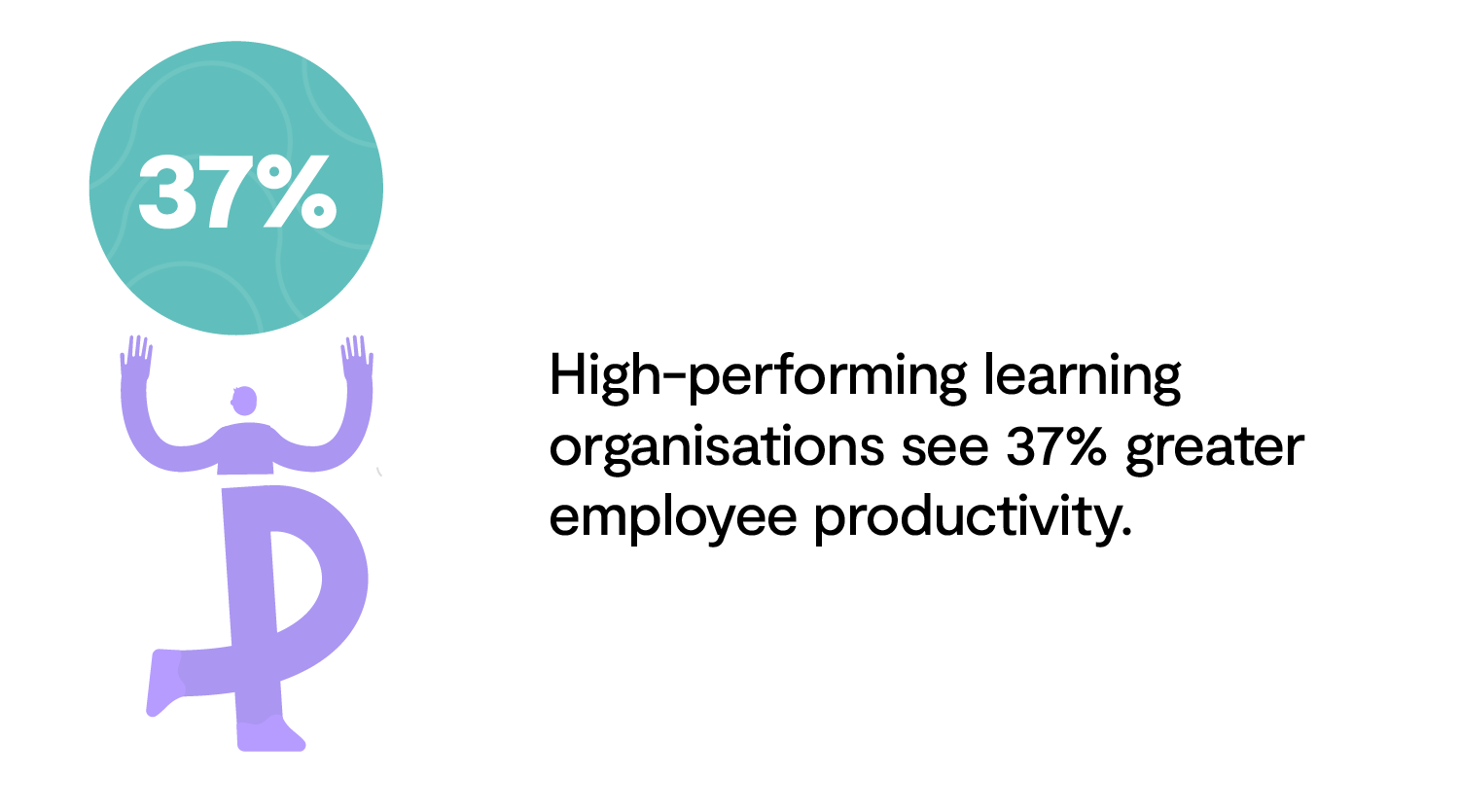
Organisational agility and success
A strong learning culture supports organisational agility and long-term success.
By encouraging employees to learn, adapt, and embrace change, organisations think more critically and become better equipped to navigate the ever-changing business landscape. A culture that values and prioritises learning enables organisations to stay competitive, innovate, and achieve their strategic goals.
According to research, high-performing learning organisations are 17% more likely to be market-share leaders.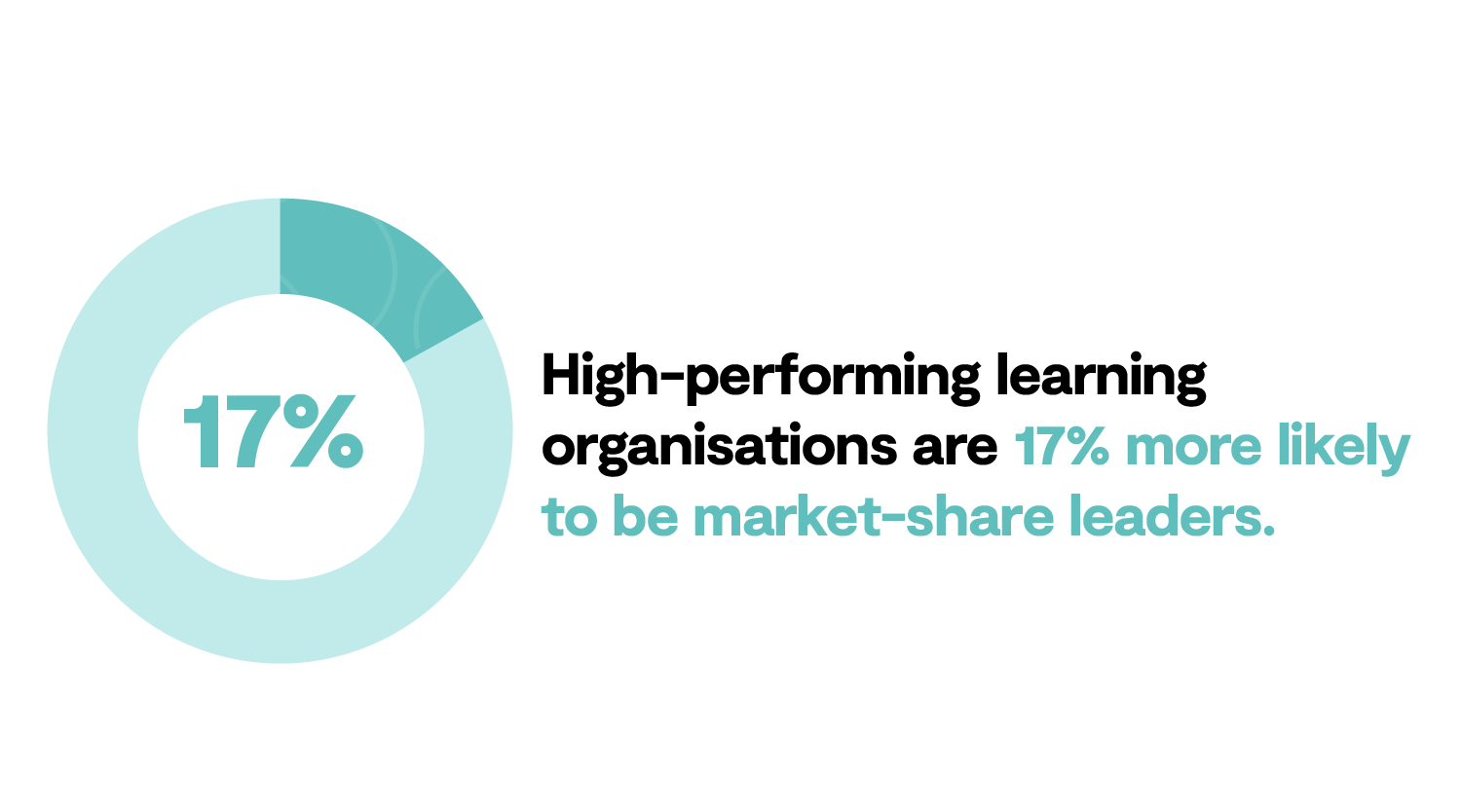

Chapter 3
Learning Culture and Engagement
Before we get stuck into the links between learning culture and employee engagement let’s explore the concept of employee experience first.
Employee experience vs employee engagement
The concept of employee experience was born out of an idea by Brian Chesky, the CEO of Airbnb, a few years ago. In 2016, the company came up with a slogan called 'Belong Anywhere', which applied not only to customers but also to employees. Instead of having a traditional HR department, Airbnb established an Employee Experience function.
Employee experience, as a concept, is closely linked to customer experience. We understand the importance of providing customers with a positive experience – great products, services, prices, and environments that keep them coming back and recommending us.
The same principle applies to employees.
By offering them a great experience, including a fulfilling job role, learning opportunities, supportive managers, a great work environment and fair compensation, they are more likely to stay with the company and speak highly of it as an employer.

And the proof of the importance of employee engagement is in the recruitment pudding. A study identified that a whopping 71% of successful job advertising comes through existing employee referrals.
And another study by Bersin shows that the second most important factor in workplace happiness for employees is the opportunity for development and that heavy learners are more confident, successful, and happy at work...
…there is a connection here.
The learning culture, whether it’s thriving or punch-you-in-the-guts-awful, has a direct impact on employee experience. Which in turn, impacts employee engagement.
This then has a flow-on effect on the learning culture.
And so, the cycle continues.
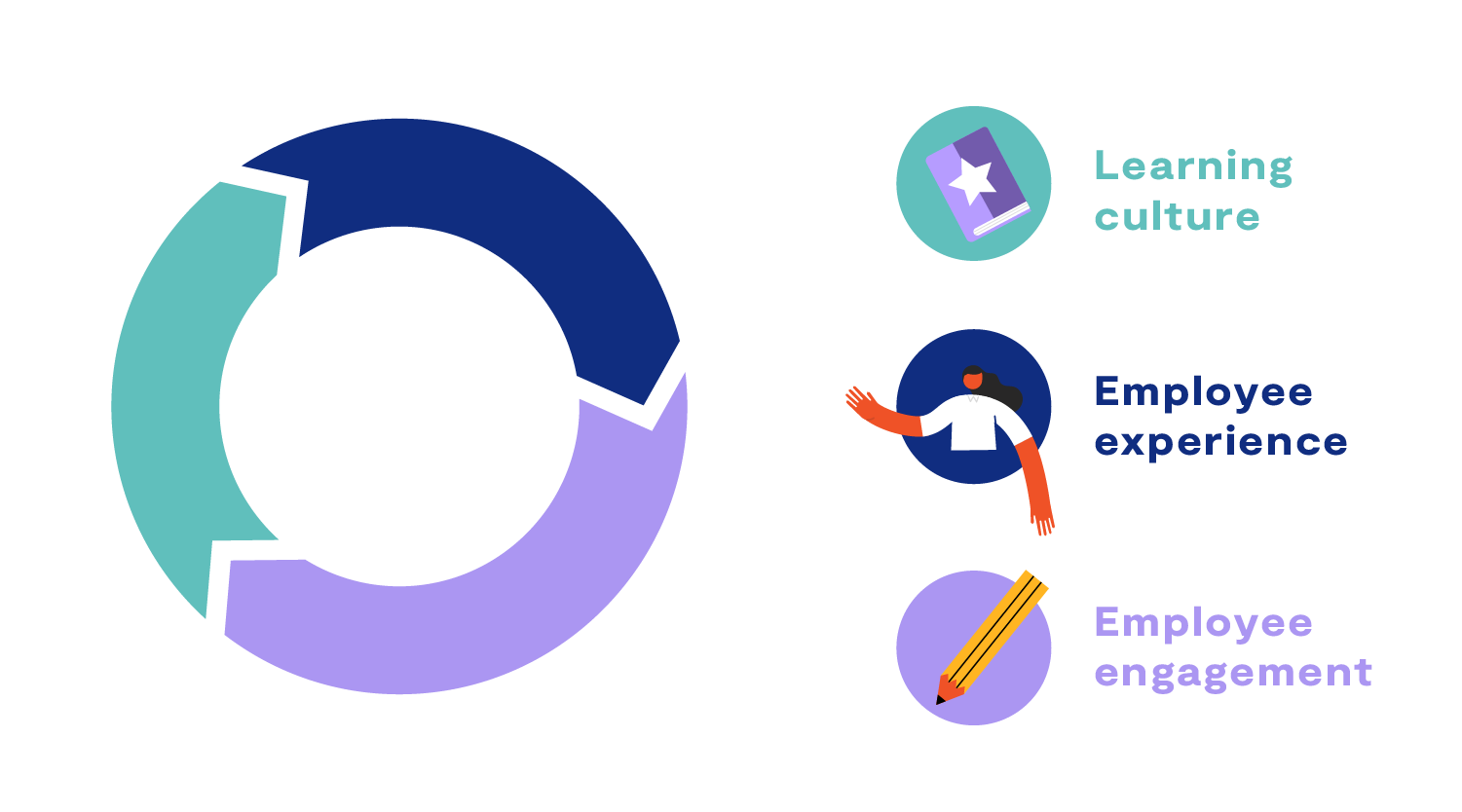
The characteristics of a learning culture that boosts employee experience and engagement
If kick-arse learning culture were a person, it’d have to be likened to a strong superhero, doing good deeds for people in the workplace. Unfortunately, some learning cultures are more like supervillains – both with very recognisable characteristics.
The good, bad and the ugly.

|
The Good: learning is integrated with work A learning culture puts a lot of support around getting better at the job and also moves beyond that. It isn’t just about learning beyond training and learning events, it knows that to learn we need resources and practice to do so. The more that learning is integrated into the flow of work the more learning needs to be available at time of need, and the better organisations need to understand those needs. |

|
The Bad and Ugly:
|

|
The Good: high psychological safety In a thriving learning culture, employees feel comfortable asking questions, sharing ideas, and taking risks without worrying about being judged or punished. Learning from mistakes is encouraged, and integrated into ways of working across the organisation. And learning experiences are designed for exploration (aha! moments) not just ‘right and wrong. Employees can have open and honest conversations which helps build trust and teamwork. |

|
The Bad and Ugly:
|

|
The Good: supportive leadership Leaders play a big role in creating a learning culture – in fact, they have a bigger impact than any HR or L&D department can have on their own. A team’s ability to be open, make decisions confidently, take on the right stretch tasks, and feel safe to make mistakes are all examples of positive practices in a great learning culture that leaders have direct influence over. |

|
The Bad and Ugly:
|

|
The Good: a focus on continuous improvement A thriving learning culture believes in continuous improvement and the practices that encourage it as a core principle. Not only does it encourage its team to look for opportunities to grow, learn from mistakes, iterate and use their learning for improvement, it does the same at an organisation level as well. |

|
The Bad and Ugly:
|

|
The Good: lots of opportunities for learning There are different ways for employees to learn, from learning design to learning in the work, and coaching and mentoring. For example, frequently giving employees tasks that stretch them developmentally, with the support to take their time and make mistakes. These opportunities are designed to suit different learning needs, and work environments, and support employees to choose what works best for them. |

|
The Bad and Ugly:
|

|
The Good: sharing ideas is encouraged A learning culture values teamwork and encourages sharing ideas and lessons learned between different teams and departments. In essence, a sense of being better together and rewarding the team, not just individuals. Employees are encouraged to collaborate, exchange best practices, and learn from each other. |

|
The Bad and Ugly:
|

|
The Good: there's recognition and reward A thriving learning culture acknowledges and rewards employees for all their efforts. When learning is linked to employees' goals and recognition of goal achievement it becomes a powerful intrinsic motivator for employees. |

|
The Bad and Ugly:
|

|
The Good: understanding that learning isn't always the answer A good learning culture also recognises learning is not always the answer. Rather than throwing bandaids on a problem, a great learning culture considers whether there are other reasons for underperformance. For example, whether workflows are effective, rather than whether team members are ineffective. It’s a holistic view of work, where employees need support and the best-in-time-of-need approach to getting it. |

|
The Bad and Ugly:
|

|
The Good: progress is monitored and feedback is given There are regular evaluations and feedback systems in place to see how well learning initiatives are working and where they can be improved. As opposed to right and wrong, there should be feedback that better represents the real-world impact of decisions so employees can improve their critical thinking outside the learning environment. Feedback helps employees understand how they're doing and make changes to their learning plans if needed. |

|
The Bad and Ugly:
|

|
The Good: a flexible and innovative environment A good learning culture is all about change, generates new ideas and seeks enabling technologies. It develops creativity, critical thinking, and problem-solving skills, which helps employees stay up to date with tools and practices that are relevant and add value to their role. The bigger transition is the integration of beyond-learning events and courses and the purposeful use of technologies. |

|
The Bad and Ugly:
|
"There’s a huge role that organisations play in setting the context and the culture for learning. Like so many things, it starts at the top, and it starts with having a CEO or a senior leader who actually values learning and talks about it very actively." Matthew Smith, Chief Learning Officer McKinsey (former)
If reading this doesn’t demonstrate how having a learning culture impacts every aspect of the organisation, we’re not sure much will sway you.
So, now you know you want it, just how can you go about creating a learning culture that puts learning at the forefront – in a way that’s practical, behavioural, and scalable – read on!
Chapter 4
Creating a Learning Culture
If we were going to describe a learning culture as a pastry, we’d have to liken it to a croissant.
There is depth and layers that go deeper and are more complex than the flaky, delicate texture you see on the outside. Building a strong learning culture involves navigating various, interconnected elements.
It requires cultivating values, fostering effective communication, promoting collaboration, supporting growth and development, and aligning with the organisation's mission and vision.
 Like each layer of a croissant, each aspect of your learning culture adds weight and richness, creating a unique and flavourful environment that engages and inspires employees.
Like each layer of a croissant, each aspect of your learning culture adds weight and richness, creating a unique and flavourful environment that engages and inspires employees.
(Hungry? Well, we’re not going to show you how to make croissants, but in case you are interested, WikiHow has the steps. https://www.wikihow.com/Make-Croissants)
 |
|
1. Set a clear vision for the future: Define a clear vision and purpose for establishing a learning culture. This could and should be part of your L&D strategy. Communicate this vision to all employees, highlighting the benefits and importance of continuous learning. Need help with your game plan? |
 |
|
2. Figure out where you are now: Begin to figure out ‘where’ you are now by evaluating the existing culture and learning practices within your organisation. This will help you to understand the current strengths and areas of focus within your organisation. Need help to do this? Answer a few quick questions using our Learning Maturity Questionnaire to identify where your company sits on the learning maturity scale. We’ve even included some impactful steps you can take to progress and improve your organisation’s future learning maturity. More about learning maturity in the next section. |
 |
|
3. Get your leaders on board asap: Leaders play a crucial role in creating a learning culture and are critical to creating psychological safety for teams to grow, innovate and explore. In their research, Bersin identified that out of the 40 high-impact practices for a learning culture, 8 are owned by top leadership, and 25 by line management! Employees should also be able to be vulnerable and transparent with leaders – and vice versa. And, leaders must actively engage in learning activities, share their own learning experiences, and demonstrate a commitment to personal growth. The question is, are your leaders on board? If not, how will you set them up for success to help you achieve your goal of creating a thriving learning culture in your organisation? |
 |
|
4. Plant the seeds of learning culture: You’ve scoped out the ‘ground’ and you’ve got your leaders onboard. Now you have to start sowing the seeds of a learning culture. Remember, Rome wasn’t built in a day. And apple trees don’t bear fruit one day after they’ve been planted. Consider making small incremental changes. You need to tend to your culture, propagate from the bits that are working and cultivate the behaviours, values and experiences you want. Not sure what these learning culture ‘seeds’ are that you should be planting? Here is a handy checklist of questions and considerations as you consider what these might be. |
 |
|
5. Set the course and stay true: Think about how you will measure and evaluate any learning initiatives currently in place, or the ones that you’ll be putting into place. You can do this by:
Regularly review and refine the learning culture strategy based on feedback and the changing learner or organisational needs. Remember to regularly update learning and re-evaluate the learning you have on offer. |
Chapter 5
How to Overcome Barriers
Now, we’ve told you that creating your learning culture is going to take some work...
And you might already have a few concerns of your own.
But, some constraints are not as limiting as they seem. Take a look at some common barriers, and why they might not be the big deal they initially seem to be.

Problem: Our employees don’t have enough time for learning
You’re right, in fact, according to Deloitte, less than 1% of employee time is available for learning. Heavy workloads and tight deadlines can make it difficult for employees to find time for learning activities, leading to a lack of participation and limited growth opportunities that can hinder your learning culture.
Solution: learning is always happening
More learning does not have to mean more time-consuming courses that take people away from their work.
With a little more time spent understanding problems and your team’s real world, you can deliver better learning solutions, to solve real problems – and most can be delivered in the flow of work. Or better still, we can solve process problems to eliminate performance issues.

Problem: we haven’t got enough resources or budget
When an organisation doesn't allocate enough resources and budget it can limit the availability and quality of learning opportunities. This highlights an issue with strategy and the mindset the organisation has about learning.
Solution: start small and develop your strategy
When you focus on the must-haves you’ll be amazed at what you can achieve on a tight budget. Start with the small stuff – get to know your teams, their problems and challenges and identify where you can use your tight budget to make the most difference.
If they know they need it, give them a resource to draw on, and if they’re unaware of it, then use another learning intervention to push it out. But whatever you do, stop using your cash on general, one-size-fits-all solutions that are getting you nowhere.
As you work on the immediate need, build your budget case by developing an effective learning strategy.
READ: 5 Slip-ups managers make when building an L&D strategy

Problem: our team are too risk-averse to make mistakes
There are a number of reasons teams might not be into our ‘failure is part of learning’ approach. Mainly it’s fear – and if it exists in your team, then there is something in the culture breeding it. We might know that the best way to learn is through our mistakes, but a culture that penalises them when they happen, discourages experimentation, prevents people from taking risks and stops empowerment and decision making in its tracks.
Solution: show them the way
It’s all about transition. You might need to start slow, but start somewhere – the only way for people to learn to take risks is to see it’s ok when they try. Maybe you start by removing those tests at the end of your modules that tell them failure is not an option (100% pass only), or you create some innovation workshops, or you simply start to loosen the reigns on the top-down decision making. Whatever you do, it’s all progress, and it starts with the organisation and its leader’s mindset about the okay-ness of failure.
READ: How to Embrace Failure in Learning

Problem: our current learning is a snooze fest
If learning resources and platforms are not easily accessible or user-friendly and worst of all, your learning is not engaging to people in your organisation (aka your learning programmes or modules suck and fall into the too-hard-basket), it’s a major barrier.
Solution: reduce the sucky stuff
Now you might think about making learning more engaging and see dollar signs piling up, but good quality learning doesn’t have to be too fancy – it’s often better if it’s not.
What it does need to do is help people solve real problems that are relevant to them. The time spent on designing learning should be focused on quality and decision making, not content within a fancy package.
READ: Lousy eLearning (and how to avoid it)

Problem: change is hard
We get it. Change is hard and constant, and usually involves some sort of letting go. And for many organisations, the consistency of change can become fatiguing, so not doing it can seem like the better decision.
Solution: focus on growth
Change can seem hard, but progress is motivating and empowering, so focus on that. Learning is all about growth, which inevitably means embracing change all the time – keep in mind the benefits you’re working towards.
To help you lead change, here is a complete guide to organisational change to get you started:
READ: Organisational Change | The Complete Guide to Navigating Change in 2023
Chapter 6
Learning Culture in Action
We’ve covered the many benefits of having a learning culture and its impacts on employee experience and engagement. And we’ve covered some steps on how you might get there.
Let’s explore learning culture in action and see some examples of other organisations that are making it work for them.
Examples of great learning cultures
Who’s getting it right when it comes to learning culture in action?

WD-40, known for its iconic multi-purpose lubricant, has a distinct company culture that fosters an environment where employees are encouraged to take risks, learn from failures, and collaborate across teams.
WD-40 also values transparency and open communication, enabling employees to freely share ideas and contribute to the company's success.
Additionally, the company places a strong emphasis on employee development and growth, providing various learning and training opportunities to enhance skills and knowledge.
Overall, WD-40 strives to maintain a positive and inclusive culture that supports its employees and drives innovation in its products and services.
READ: How WD-40 Created a Learning-Obsessed Company Culture

Microsoft has a strong learning culture that emphasises continuous improvement, collaboration, and individual growth.
They provide employees with various opportunities for learning and development, including access to online platforms, training courses, certifications, and internal knowledge-sharing resources. Microsoft promotes a growth mindset, encourages collaboration and knowledge sharing, and values ongoing learning and feedback.
Their learning culture supports employee growth, drives innovation, and empowers individuals to reach their full potential.
READ: Learning, Empathy and Diversity Have Put Microsoft on a Path of Unstoppable Growth
These two organisations show us something awesome about how they’ve created a learning culture – but there’s something more here. We talked about creating a learning culture in the previous section, let’s explore the idea of learning maturity further.
What is learning maturity within an organisation?
Learning maturity refers to the level of development and effectiveness of an organisation's L&D practices. Learning maturity:
- assesses the organisation's ability to create a culture that values and supports continuous learning
- assesses the organisation's capability to design and implement effective learning programmes and initiatives
- considers factors such as the organisation's learning strategy, leadership support, learning infrastructure, resources allocated to learning, employee engagement in learning activities, and the evaluation of learning outcomes.
The Inspire Group Learning Maturity Model
Every organisation sits somewhere in one of the five stages of learning maturity. From limited ad-hoc, haphazard training driven by compliance and workplace issues, to a performance-focused, human-centred, innovative learning organisation.
Can you plot where you think our examples of WD-40 and Microsoft might sit?
A higher learning maturity indicates that the organisation has a well-established and integrated approach to learning that contributes to its overall performance and success.
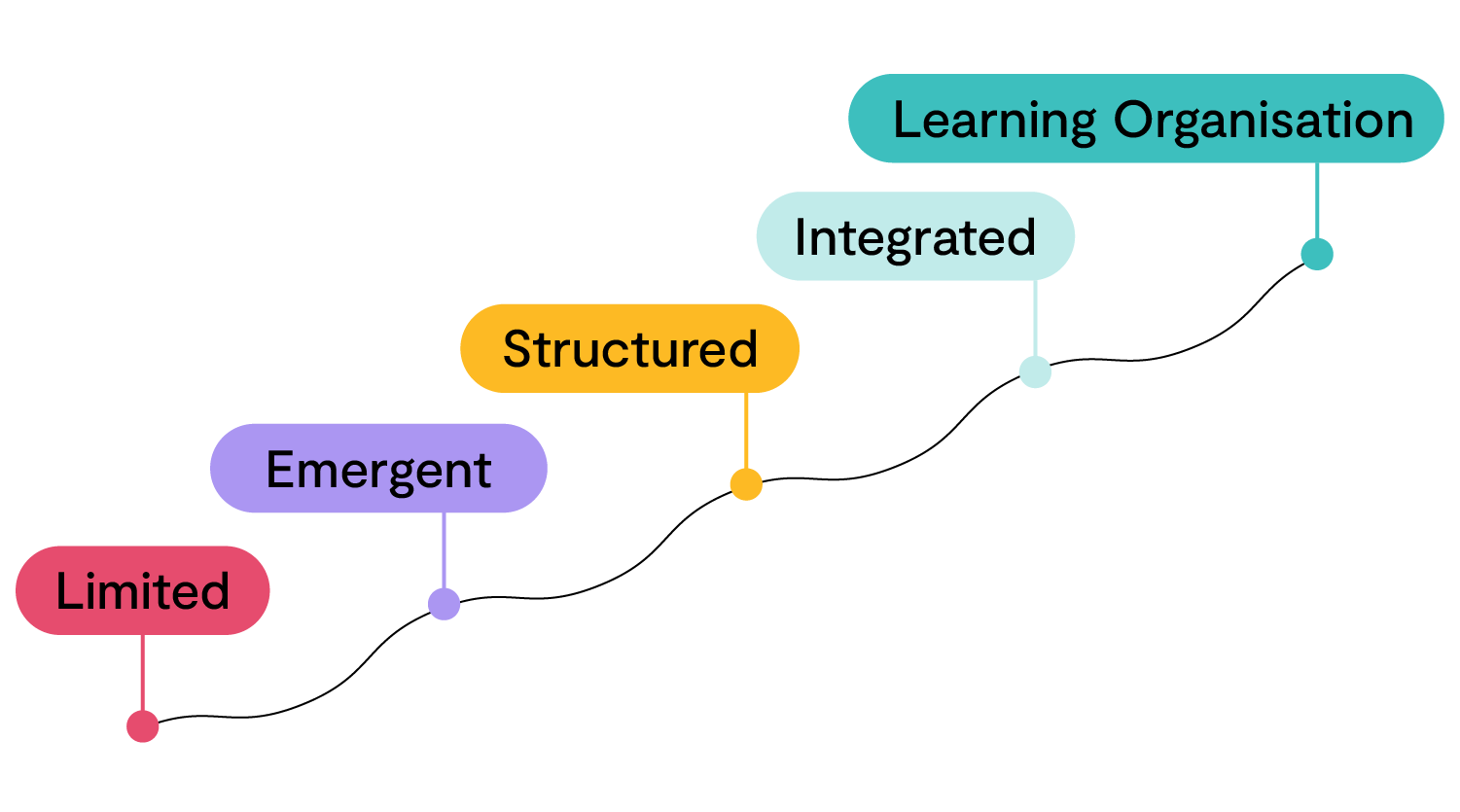
You might already have an idea where your organisation may be in this model. If you haven’t taken the learning maturity test yet, now is the time.
ACCESS: Take the Inspire Group Learning Maturity Model Assessment
![]()
Chapter 7
A Few Best-Practice
Tips
There are many more organisations than the ones we’ve mentioned, who are flexing their learning culture muscles.
Once you have successfully established a flourishing learning culture in your organisation, it’s essential to maintain and nurture it. And, just like working out, you can’t simply go to the gym once or do a 6-week program and expect results to last without further effort.

Here are the top 5 tips to maintain your learning culture.
By following these tips, you can ensure that your organisation's learning culture remains vibrant and impactful, just like a well-maintained fitness routine that leads to long-term health and success.
 |
Consistency is key: Just like maintaining a healthy fitness routine, consistency is crucial in sustaining a learning culture. Your employees should know that you'll keep ‘showing up for them’. Your organisation's approach to learning and learning culture should stand the tests of time. |
 |
Set goals and track progress: Similar to setting fitness goals, establish learning goals for individuals, teams and the organisation. Remember, learning culture is not just the measure of your learning experience or L&D function – you need to consider the organisational practices that create your learning culture and design and track the metrics that move you in the right direction.
|
 |
Embrace variety and challenge: Like diversifying your workouts to avoid plateaus and keep you motivated, think about how you can embrace variety and challenge to create your learning culture. While your team’s understanding of the value of learning should remain consistent, this does not mean your learning stays still. Challenge how you do things, ask yourself if you need to consider different approaches, ask why you’re doing things the way you are now and if they are the most effective approaches. When it comes to your learners, try new things and test them with your employees. Keep promoting a wide range of learning experiences. Offer a mix of learning methods, encourage the exploration of new skills and knowledge areas, and challenge employees to step outside their comfort zones.
|
 |
Foster a supportive community: Just as gym buddies provide motivation and encouragement, create a supportive learning community within your organisation. Continue to encourage knowledge sharing, mentoring and collaborative learning opportunities, allowing employees to learn from each other and build strong connections. Remember, learning is not about perfection. Get learners involved and co-create learning with them – this is a human-centred approach designed with them in mind.
|
 |
Adapt and evolve: Similar to adjusting your fitness routine to match changing goals or circumstances, be adaptable in your learning initiatives. Keep asking for feedback from employees, and continuously refine your learning strategies to meet the evolving needs of your employees and organisation.
|
Remember, maintaining a learning culture is an ongoing process that requires commitment, engagement and adaptability.
A final message about learning culture
We’ve covered the essence and importance of a positive and flourishing learning culture in organisations. We explored what it is, why it matters and the history behind it. We also looked at how improving the learning culture benefits individuals, teams and organisations. We provided practical tips and examples on how to create and foster a learning culture, along with best practices to support its growth. We think this final quote by Josh Bersin sums up so well what we’ve covered:
“Finally, let me mention the importance of building a learning culture. Regardless of your efforts to build great content and hire the best, the culture of learning always prevails.
Do people have time to learn?
Do they feel a sense of empowerment and belonging in the program?
Does the experience “meet them where they are”?
Is there an expert, teacher, or facilitator to make sure employees can really get what he or she needs as they push themselves to the next level?
Nothing creates a learning culture more than groups of people activated to learn together.
New ideas, conversations, and talking about solutions create memorable skills we all carry for a lifetime. As you select your tools and build your strategy, make sure the focus on human-supported, group-based learning remains at the core. You’ll be glad you did.”
About the author
Mitty's personal motto is “Just be an excellent person” and that’s what she will take into every aspect of her life whether that includes creating kickass learning solutions, hugging horses or jamming on the steelpan drums. Seeing people become their best selves is what excites Mitty most – and that’s where her passion for learning comes from! Mitty uses her strengths as a Learning and Development consultant and creative flair and humour to get down to the core of what makes learning effective for each learning audience.






